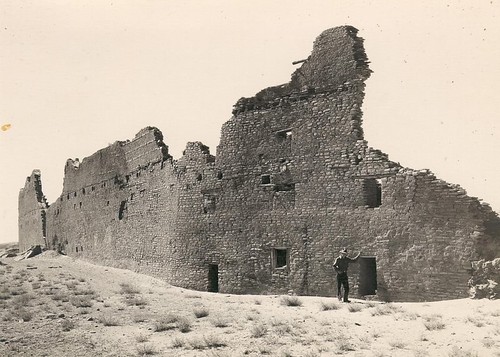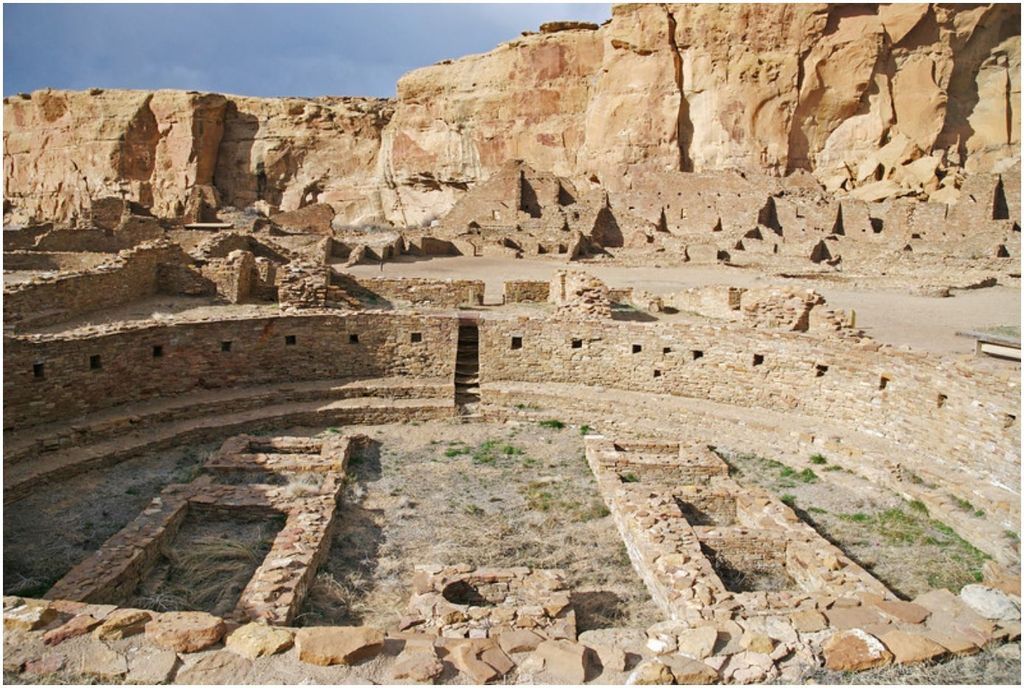This photo from the 1930s shows the back wall of Pueblo Bonito, the largest structure found in Chaco Canyon, New Mexico. Archaeologists estimate the intact structure was 5 stories high and had about 500 rooms. University of Arizona tree-ring studies of building's wooden beams revealed the structure was built in phases from 850 to 1120. Credit: George A. Grant/ National Park Service

1 posted on
12/08/2015 2:56:06 PM PST by
SunkenCiv
To: SunkenCiv
Visted Chaco a few years back. It’s a must see place in beautiful country.
3 posted on
12/08/2015 2:57:47 PM PST by
riri
(Obama's Amerika--Not a fun place.)
To: SunkenCiv
Pretty darned impressive. And, it was done without the help of IC engines, CAD, etc.
4 posted on
12/08/2015 3:00:58 PM PST by
Da Coyote
To: SunkenCiv
Been there. Seen that.
Condos for the Indians.
The community had only two problems:
1. The river ran dry
2. They were cannibals.
5 posted on
12/08/2015 3:02:53 PM PST by
HomerBohn
(Liberals and slinkies: they're good for nothing, but you smile as you shove them down the stairs.)
To: SunkenCiv
Incredible site. I’ve been to Chaco Canyon twice when I was still living in Arizona. There are also dozens of fascinating sites in the four corners area. The Pueblos and the Hopi seem dependents with likely additional cultures. Zuni is also well worth a trip.
7 posted on
12/08/2015 3:05:24 PM PST by
JimSEA
To: SunkenCiv
8 posted on
12/08/2015 3:07:53 PM PST by
ETL
(Ted Cruz 2016!! -- For a better, safer America)
To: SunkenCiv
Hotel for visiting aliens?
To: SunkenCiv
It appears that a major climate change occurred that left that area without water.
13 posted on
12/08/2015 3:14:50 PM PST by
Purdue77
("...shall not be infringed.")
To: SunkenCiv
um, unexpected wood...
Happened to me in sixth grade when I had to get up to sharpen a pencil.
14 posted on
12/08/2015 3:15:54 PM PST by
JohnnyP
To: SunkenCiv
This is interesting. In the 90s, I did some petrographic microscopy for the UA Anthropology Department on Chaco Canyon pottery, comparing the contained sand grains to various source rocks, some of which were from the Chuskas.
Then my wife and I visited Chaco Canyon a few years ago, as well as other archeological sites in the Four Corners area.
To: SunkenCiv
Horses were introduced to America by early post-Columbian explorers. Prior to that time, trees had to be moved from the Zuni and Chuska mountains by human labor. It must have been an enormous effort over nearly three centuries to cut (using stone tools) and move the estimated 240,000 trees used in construction.
19 posted on
12/08/2015 3:46:54 PM PST by
CedarDave
(Hillary for incarceration not inauguration)
To: SunkenCiv
Interesting. One thing I couldn’t find was what wood are we’re talking here? Fir, pine, cypress, or some kind of hardwood? Oh well.
23 posted on
12/08/2015 4:32:17 PM PST by
Lurkina.n.Learnin
(It's a shame enobama truly doesn't care about any of this. Our country, our future, he doesn't care)
To: SunkenCiv
Many parts of Chaco Canyon can be reinterpreted to mean very different things from the official archaeology.
To start with, it was the center of a major transshipment route all the way from New England to South America. Perhaps comparable to Chicago today. It was also something of a “banking center”, in that at the time the reserve trading currency was turquoise chips, tens of thousands of which have been discovered there.
Something that can be noted on the site are the many underground “kivas” or rooms, or at least that is the assumption, until you notice that adjacent kivas are stair stepped down, so may have instead been cisterns.
The buildings there often have basements, as well as several floors, and the different construction masonry techniques are very obvious.
About halfway from Chaco Canyon to Albuquerque is the Petroglyph National Monument, a black basalt mesa cliff face with some 24,000 petroglyphs on it. Perhaps it was the Free Republic forum from a thousand years ago.
27 posted on
12/08/2015 5:13:35 PM PST by
yefragetuwrabrumuy
("Don't compare me to the almighty, compare me to the alternative." -Obama, 09-24-11)
To: SunkenCiv
I have never felt as “at home” as I have at Chaco. It is certainly one of those places that you should experience. If you think “civilization” is a new thing, you need to go there and see what happened a long time ago.
29 posted on
12/08/2015 5:40:53 PM PST by
Vermont Lt
(I had student debt. It came from a bank. Not from the Govt.)
To: SunkenCiv
I wonder what happened to the guy who suggested that the buildings be built near the trees?
The Zuni Enigma
"The peaceful Zuni of New Mexico and Arizona are much studied, partly because their language, culture and physical appearance set them apart from other Native American peoples. Davis, an anthropologist who has made 10 visits to the Zuni pueblo, now offers the startling thesis that a group of Japanese Buddhists left earthquake-wracked medieval Japan and came by ship to the Southern California coast, eventually migrating inland to the Zuni territory, where they merged their culture and genes with Native Americans to produce the modern Zuni people around A.D. 1350. Davis uses "forensic" evidence--including analyses of dental morphology, blood and skeletal remains--to support a Japanese-Zuni connection."
31 posted on
12/08/2015 6:04:24 PM PST by
blam
(Jeff Sessions For President)
To: SunkenCiv
Went to Chaco recently. It is massive. There are multiple building sites, but Pueblo Bonito is the largest. The picture above doesn't do it justice. It's just something that has to been seen in person to understand how massive. Not only that, but at 6' 2" tall, my head would have been smack in the middle of the upper floor supports. There were three types of doorways, somewhat short and narrow (around 5' or so), shorter and wider (I'm 6' 2" and had to get on my knees to go through, and some that were like a thick capital "T", about 30" wide at the bottom, with the cross opening being about the same.
They were not big folks.
32 posted on
12/08/2015 6:18:04 PM PST by
IYAS9YAS
(I got nothin'.)
To: SunkenCiv
A picture from the 1930s. Does that mean the wall is no longer there?
45 posted on
12/09/2015 6:47:01 AM PST by
Lee'sGhost
("Just look at the flowers, Lizzie. Just look at the flowers.")
FreeRepublic.com is powered by software copyright 2000-2008 John Robinson

